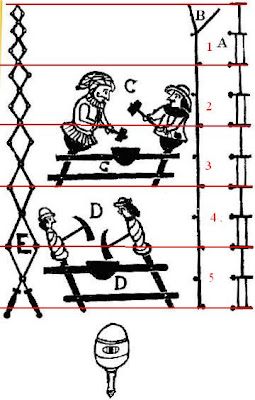I know I’ve said this before but I find it puzzling to say the least, that the sheer ubiquity of the thinly veiled insinuations by Johann Bessler, that somehow the number five is of tremendous importance, seems to be largely ignored. Equally perplexing is the opposite adherence to just one other clue that mentions on a single occasion, “….the sound of about eight weights landing on the side towards which wheel turned”. It’s my impression that Bessler-world spends an inordinate amount of time fixated on this supposed fact, while ignoring Bessler’s admission that he had, on occasion, muffled the sound with felt.
He altered his forenames from Elias Bessler to Johann Ernst Elias Bessler. This, coupled with the adoption of his strange pseudonym, Orffyreus through the application of the ancient Hebrew code, atbash, as it was known, led me to do the same to his initials and convert JEEB to WRRO..
E being the 5th letter of the alphabet, chimed with the pentagram being a circle of fifths, and there were two of them. This also connected with his comment in AP, that his weights operated in pairs.
The letter J, the tenth letter of the alphabet, seemed superfluous, however once I applied the atbash cipher to JEEB and got WRRO, I understood the presence of the J and W. The W can be seen to be composed of two Roman number 5s. Bessler always wrote his Ws as two interlinked Vs, suggesting again two 5s, or two fifths, were working together as a pair.
Notice the names of his sworn enemies, their surname initial and then their whole surname in the above picture from AP, Gartner, Wagner and Bosz.
The letter R is the 18th letter of the alphabet and is also the basic number used in the pentagram. In fact every number in the pentagram is a multiple of that figure - 18, 36, 54, 72, 90 and 108. All of these are used in Bessler’s wheel. Notice there are two letter Rs in the images of his signature below, supporting the letter O. One for each direction.
The letter O, serves Bessler well as a representation of his wheel, with a dot in the middle representing the wheel itself, it is known as a circumpunct,
The above examples of coding that Bessler was able to use have one thing in common, they have proved remarkably convenient and apt for his purposes. How fortunate that the 5th letter E should have as it’s atbash equivalent the letter R, the 18th letter. 5 and 18, the basic numbers of the pentagram. He chose the letter J, the 10th letter because it’s atbash equivalent is W to provide the information that two 5s were interlinked as pairs. The letter O, the atbash equivalent of his B for Bessler, within the same cipher provided the circumpunct, the perfect symbol for his wheel.
These simple facts raised questions in my mind. Was it just coincidence that E/5 and R/18 were each in their precise positions alphabetically, to imply a relationship with the pentagram - or was there some other factor or agent which positioned those two letter/numbers to both be present at the right place? One way to see if there was anything other than coincidence would be to see how long the alphabet has been in the same order.
It seems, from a brief search, that the alphabet order has always been the same. This is because it was taught to children while they were learning to read and they taught their children and so on. Of course letters were added and removed from time to time dependent on the language used. But it can be traced back almost 2000 years before CE and those letters remained in their current position for at least 4000 years - but that doesn’t answer the question.
One theory suggests every letter had a number with it in order to keep it in the right position, and the numbers were dropped over time. But the atbash cipher wouldn’t work if the number/ letters were in a different position, which suggests that the placing was deliberately chosen.
Someone, at some point, thousands of years ago arranged the order of the alphabet and it hasn’t changed much in most cases. It would be interesting to find some confirmation that E/5 and R/18 were placed in their positions for the reason I suggested - or is that a stretch too far and it’s just a coincidence!
There is more to this than meets the eye and it’s something that may help us unravel Bessler’s puzzling “Declaration of Faith” in chapter 55 of his “Apologia Poetica”. He placed 141 abbreviated Bible references at the end of short lines of text, which seem unconnected to the subject matter in the references. Some of the references do not exist; for instance, in some cases the number of verses quoted are more than can be found.
I’m currently investigating the output of Christian Weise, Bessler’s teacher who published ideas about the use of number/letter alphabets; also David Heinichen, promoter of his “Circle of Fifths” and the composer JS Bach and “the Riddle of the Number-Alphabet”. The latter three knew each other, lived within a short distance of each other and at the same time. All three people were involved in the theory of music and the last two wrote extensively on the use of letter/numbers in both music and texts.
JC













